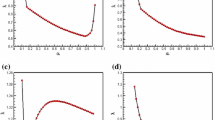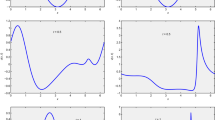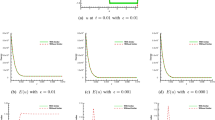Abstract
In this article, we present a second-order in time implicit–explicit (IMEX) local discontinuous Galerkin (LDG) method for computing the Cahn–Hilliard equation, which describes the phase separation phenomenon. It is well-known that the Cahn–Hilliard equation has a nonlinear stability property, i.e., the free-energy functional decreases with respect to time. The discretized Cahn–Hilliard system modeled by the IMEX LDG method can inherit the nonlinear stability of the continuous model. We apply a stabilization technique and prove unconditional energy stability of our scheme. Numerical experiments are performed to validate the analysis. Computational efficiency can be significantly enhanced by using this IMEX LDG method with a large time step.



Similar content being viewed by others
References
Arnold, D.N., Brezzi, F., Cockburn, B., Marini, L.D.: Unified analysis of discontinuous Galerkin methods for elliptic problems. SIAM J. Numer. Anal. 39, 1749–1779 (2002)
Ascher, U.M., Ruuth, J., Spiteri, R.J.: Implicit–explicit Runge-Kutta method for time dependent partial differential equations. Appl. Numer. Math. 25, 151–167 (1997)
Ascher, U.M., Ruuth, J., Wetton, T.R.: Implicit–explicit method for time dependent partial differential equations. SIAM. J. Numer. Anal. 32, 797–823 (1995)
Bassi, F., Rebay, S.: A high-order accurate discontinuous finite element method for the numerical solution of the compressible Navier–Stokes equations. J. Comput. Phys. 131, 267–279 (1997)
Brezis, H., Gallout, T.: Nonlinear Schrodinger evolution equations. Nonlinear Anal. Theory Meth. Appl. 4, 677–681 (1980)
Cahn, J.W., Hilliard, J.E.: Free energy of a nonuniform system. I. Interfacial free energy. J. Chem. Phys. 28, 258–267 (1958)
Choo, S.M., Chung, S.K., Kim, K.I.: Conservative nonlinear difference scheme for the Cahn–Hilliard equation-II. Comput. Math. Appl. 39, 229–243 (2000)
Cockburn, B., Shu, C.-W.: The local discontinuous Galerkin method for time-dependent convection–diffusion systems. SIAM J. Numer. Anal. 35, 2440–2463 (1998)
Furihata, D.: A stable and conservative finite difference scheme for the Cahn–Hilliard equation. Numer. Math. 87, 675–699 (2001)
Dong, B., Shu, C.-W.: Analysis of a local discontinuous Galerkin method for linear time-dependent fourth-order problems. SIAM J. Numer. Anal. 47, 3240–3268 (2009)
Elliott, C.M., French, D.A.: A nonconforming finite element method for the two-dimensional Cahn–Hilliard equations. SIAM J. Numer. Anal. 26, 884–903 (1989)
Elliott, C.M., Larsson, S.: Error estimates with smooth and nonsmooth data for a finite element method for the Cahn–Hilliard equation. Math. Comput. 58, 603–630 (1992)
Elliott, C.M., Stinner, B.: Computation of two-phase biomembranes with phase dependent material parameters using surface finite elements. Commun. Comput. Phys. 13, 325–360 (2013)
Eyre, D.J.: An unconditionally stable one-step scheme for gradient systems. Available at http://www.math.utah.edu/~eyre/research/methods/stable.ps (1998)
Eyre, D.J.: Unconditionally gradient stable time marching the Cahn–Hilliard equation. Mater. Res. Soc. Sympos. Proc. 529, 39–46 (1998)
Feng, X.L., Song, H., Tang, Tao, Yang, J.: Nonlinear stability of the implicit–explicit methods for the Allen–Cahn equation. Inverse Probl Imaging 7, 679–695 (2013)
Guo, R., Xu, Y.: Efficient solvers of DG discretization for the Cahn–Hilliard equations. SIAM J. Sci. Comput. 58, 380–408 (2014)
He, Y.N., Liu, Y.X., Tang, T.: On large time-stepping methods for the Cahn–Hilliard equation. Appl. Numer. Math. 57, 616–628 (2007)
Li, D., Qiao, Z.: On second order semi-implicit fourier spectral methods for 2D Cahn–Hilliard equations. J. Sci. Comput. 70, 301–341 (2017)
Qiao, Z., Zhang, Z., Tang, T.: An adaptive time-stepping strategy for the molecular beam epitaxy models. SIAM J. Sci. Comput. 33, 1395–1414 (2011)
Shen, J., Yang, X.: Numerical approximations of Allen–Cahn and Cahn–Hilliard equations. Discrete Contin. Dyn. Syst. A 28, 1669–1691 (2010)
Song, H.: Energy stable and large time-stepping methods for the Cahn–Hilliard equation. Inter. J. Comput. Math. 92, 2091–2108 (2015)
Sun, Z.Z.: A second-order accurate linearized difference scheme for the two-dimensional Cahn–Hilliard equation. Math. Comput. 64, 1463–1471 (1995)
Xu, C., Tang, T.: Stability analysis of large time-stepping methods for epitaxial growth models. SIAM J. Num. Anal. 44, 1759–1779 (2006)
Xu, Y., Shu, C.-W.: Local discontinuous Galerkin methods for high-order time-dependent partial differential equations. Commun. Comput. Phys. 7, 1–46 (2016)
Wang, H., Wang, S., Zhang, Q., Shu, C.-W.: Local discontinuous Galerkin methods with implicit–explicit time-marching for multi-dimensional convection–diffusion problems. ESAIM: Math. Model. Numer. Anal. 50, 1083–1105 (2016)
Zhang, Z., Qiao, Z.: An adaptive time-stepping strategy for the Cahn–Hilliard equation. Commun. Comput. Phys. 11, 1261–1278 (2012)
Acknowledgements
We would like to thank the referees for their constructive comments and suggestions which have led to an improvement of the paper.
Author information
Authors and Affiliations
Corresponding author
Additional information
The first author was supported by NSFC (Grant No.11301167), Natural Science Foundation of Hunan Province, China (Grant No.14JJ3063) and by the China Scholarship Council (CSC). The second author was supported by DOE Grant DE-FG02-08ER25863 and NSF Grant DMS-1418750.
Appendices
Appendix A: The Proof of Proposition 1
Due to the linearity and finite dimensionality of the problem, it is enough to show that the only solution to (19) and (20) with \(u=0\) is \(v_h=0\).
Taking \(\tau =\sigma _h\) and \(\eta =v_h\),
Applying integration by parts, and adding the two equations, we get
Summing over K, we can obtain
which implies \(\sigma _h=0\). Using the relationship (21), we have \(\nabla v_h=0\) on every K and \( [v_h]=0\), since \(\mu >0\). Then \(v_h|_K=C\). Because of \([v_h]=0\), \(v_h=C\). However
which implies \(v_h=0\). Thus we have completed the proof.
Appendix B: The Proof of Lemma 3
Using the LDG discrete “inverse Laplacian” and taking \(\tau =\sigma _h^{n+1}\) and \(\eta =v_h^{n+1}\) in (22),
Then
Summing over K and using the Lemma 1, we can obtain the result (24).
Note that \(\delta ^2 u^{n+1}=u^{n+1}-2u^n+u^{n-1}\), clearly
Similarly, taking \( \eta =v_h^{n+1}\) and \(\tau =\sigma _h^{n+1}-\sigma _h^{n}\),
So that
Summing over K and using the Lemma 1, we can obtain the result (25). This completes the proof.
Appendix C: The Proof of the Lemma 7
Taking \(\rho =\varepsilon ^{2}u^1, \mathbf q =-\varepsilon ^{2}\mathbf {w}^1, \phi =p^1-r^0, {\psi }=\varepsilon ^{2}(\mathbf {s}_1^{0}-\mathbf s _2^1)\) in Eqs. (51), and using the same analysis as the Lemma 6, we have
Summing up over K,
So we have the result
and
By the definition of the discrete Laplacian operator,
Then Taking \(\phi =-\Delta _h u^1\), we obtain
Next, taking \(\rho =v_h^1=(-\Delta )^{-1}(u^1-u^0), \mathbf q =\sigma _h^1, \phi =u^1-u^0,\xi =u^1-u^0\) in Eqs. (51), and
using the same argument as Eqs. (36)–(48), then
Using Lemmas 1, 3, and summing on K,
So that
Finally, by the Lemma 4,
Rights and permissions
About this article
Cite this article
Song, H., Shu, CW. Unconditional Energy Stability Analysis of a Second Order Implicit–Explicit Local Discontinuous Galerkin Method for the Cahn–Hilliard Equation. J Sci Comput 73, 1178–1203 (2017). https://doi.org/10.1007/s10915-017-0497-5
Received:
Revised:
Accepted:
Published:
Issue Date:
DOI: https://doi.org/10.1007/s10915-017-0497-5




